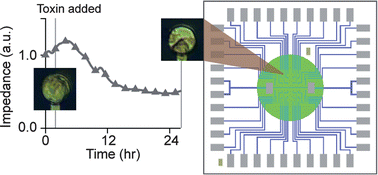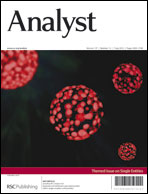Abstract
Cellular impedance sensors have attracted great attention as a powerful characterization tool for real-time, label-free detection of cytotoxic agents. However, impedance measurements with conventional cell-based sensors that host multiple cells on a single electrode neither provide optimal cell signal sensitivity nor are capable of recording individual cell responses. Here we use a single-cell based platform to monitor cellular impedance on planar microelectrodes to characterize cellular death. In this study, individual cells were selectively patterned on microelectrodes with each hosting one live cell through ligand-mediated natural cell adhesion. Changes in cellular morphology and cell–electrode adherence were monitored after the patterned cells were treated with varying concentrations of hydrogen peroxide, sodium arsenite, and disodium hydrogen arsenate, three potent toxicants related to neurotoxicity and oxidative stress. At low toxicant concentrations, impedance waveforms acquired from individual cells showed variable responses. A time- and concentration-dependent response was seen in the averaged single-cell impedance waveform for all three toxicants. The apoptosis and necrosis characterizations were performed to validate cell impedance results. Furthermore, time constants of apoptosis and necrosis in response to toxicant exposure were analytically established using an equivalent circuit model that characterized the mechanisms of cell death.

- This article is part of the themed collection: The ‘Single’ Issue

 Please wait while we load your content...
Please wait while we load your content...